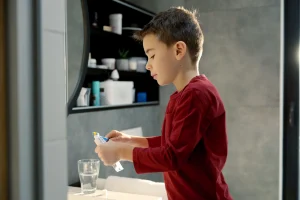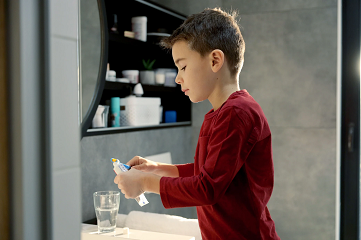What is fluoride?
Fluoride is a natural mineral found throughout the earth’s crust and widely distributed in nature. Some foods and water supplies contain fluoride.
How does fluoride fight the decay?
-
Fluoride helps to harden the enamel coating that protects teeth from the acid produced by decay-causing bacteria. It reduces the solubility of enamel in acid by converting hydroxyapatite into less soluble fluorapatite-hydroxyapatite is the building block for the enamel.
-
Newer experiments revealed that fluoride reduces the ability of decay-causing bacteria to stick, so that also on teeth, it is easier to wash away the bacteria by saliva, brushing and other activity (Journal Reference:Peter Loskill, Christian Zeitz, Samuel Grandthyll, Nicolas Thewes, Frank Müller, Markus Bischoff, Mathias Herrmann, Karin Jacobs. Reduced Adhesion of Oral Bacteria on Hydroxyapatite by Fluoride Treatment. Langmuir, 2013)
-
It exerts an influence directly on dental plaque, reducing the ability of plaque organisms to produce acid
-
It promotes the remineralization of tooth enamel in areas that have been decalcified by acids.
Most likely, fluoride works by a combination of these effects. But the remineralization effect of fluoride is the most important one, because it reverses the early caries process and it gives rise to an enamel surface that is more resistant to decay.
The optimum concentration of fluoride to protect the teeth from decay depends on the mode of delivery. Fluoride can be delivered locally in form of tooth paste, tooth varnish or mouth wash or it can be taken as a supplement in forms of fluoridated water or tablets.
 Water fluoridation
Water fluoridation
In the 1930s, researchers found that people who grew up drinking naturally fluoridated water had up to two-thirds fewer cavities than people living in areas without fluoridated water. Studies since then have repeatedly shown that when fluoride is added to a community’s water supply, tooth decay decreases. The World Health Organization ,British Oral Health foundation, British Dental association and many other organizations, have endorsed the use of fluoride in water supplies because of its effect on tooth decay.
The optimum concentration of fluoride in drinking water in 1 part of fluoride per million parts of water.
Over 6.1 million people in the UK receive water with a fluoride content, whether naturally occurring or added. This means that about 10% of the total population is supplied with optimally fluoridated water.
People living in Hartlepool and Easington in the north east of England, Uttoxeter in Staffordshire and parts of north Hampshire and south Berkshire receive water supplies with naturally occurring fluoride at the optimum level (around one part of fluoride per million parts of water-1ppm)
Around 5.8 million people in different parts of England are supplied with artificially fluoridated water. In these communities, the naturally occurring fluoride is too low to protect teeth from decay and has therefore been supplemented at the water treatment works to bring it up to the 1 ppm concentration. (telegraph24 Feb 2015)
Fluoride supplement
Fluoride in foods, supplements and water enters the bloodstream through the stomach. From there, it is absorbed into the body. In children, the fluoride then becomes available to the teeth that are developing in the jaw. Ingested fluorides do not add fluoride to the teeth in someone older than age 16. Fluoride supplements also are available by prescription. They usually are reserved for children who live in areas where the water supply does not contain enough fluoride. Children who need supplements receive them from ages 6 months to 16 years.
Fluoride Treatments
Topical fluoride products are applied directly to the teeth. They include toothpaste, mouth rinses and professionally applied fluoride treatments. Topical fluoride treatments are in the mouth for only a short time. However, fluoride levels in the mouth remain higher for several hours afterward.
Professional fluoride treatments are given in a dental practice. They are applied as a gel, foam or varnish. The fluoride used for these treatments has a higher concentration than over-the-counter or prescription mouthwashes or toothpastes.
Fluoride toothpastes
Dentists recommend using fluoride toothpaste to prevent decay. Fluoride has been proven to reduce tooth decay by at least 40 percent, so everyone should be encouraged to use fluoride toothpaste.
It is important to use only a small, pea-sized smear of toothpaste for children, as they are likely to swallow some of it. After brushing you should spit out the toothpaste rather than rinsing, to prevent the fluoride being washed away.
If your dental team feel that you have a high risk of tooth decay, they may recommend and prescribe a toothpaste with more fluoride in it. This high level of fluoride can offer more protection to people more at risk of decay.
Is fluoride safe?
Many reports have been published throughout the world about fluoride. After many years, the scientific conclusion is that fluoride toothpaste and correctly fluoridated water, salt and milk are of great benefit to dental health, help to reduce decay, and cause no harmful side effects to general health. Studies have not found any evidence that fluoride added to water causes harmful side effects.
People who are against fluoridation claim they have firm evidence that fluoride added to water is harmful. However, scientific analysis has not supported their claims.
Worldwide, over 300 million people drink fluoridated water supplies. Many millions more use fluoride toothpastes regularly.. This has led to improved levels of dental health which in turn benefits general health. Fluoride is safe and effective when used properly. All water-fluoridation systems are checked daily to maintain safe fluoride levels for drinking. Parents should supervise the use of all fluoride products in the home.

